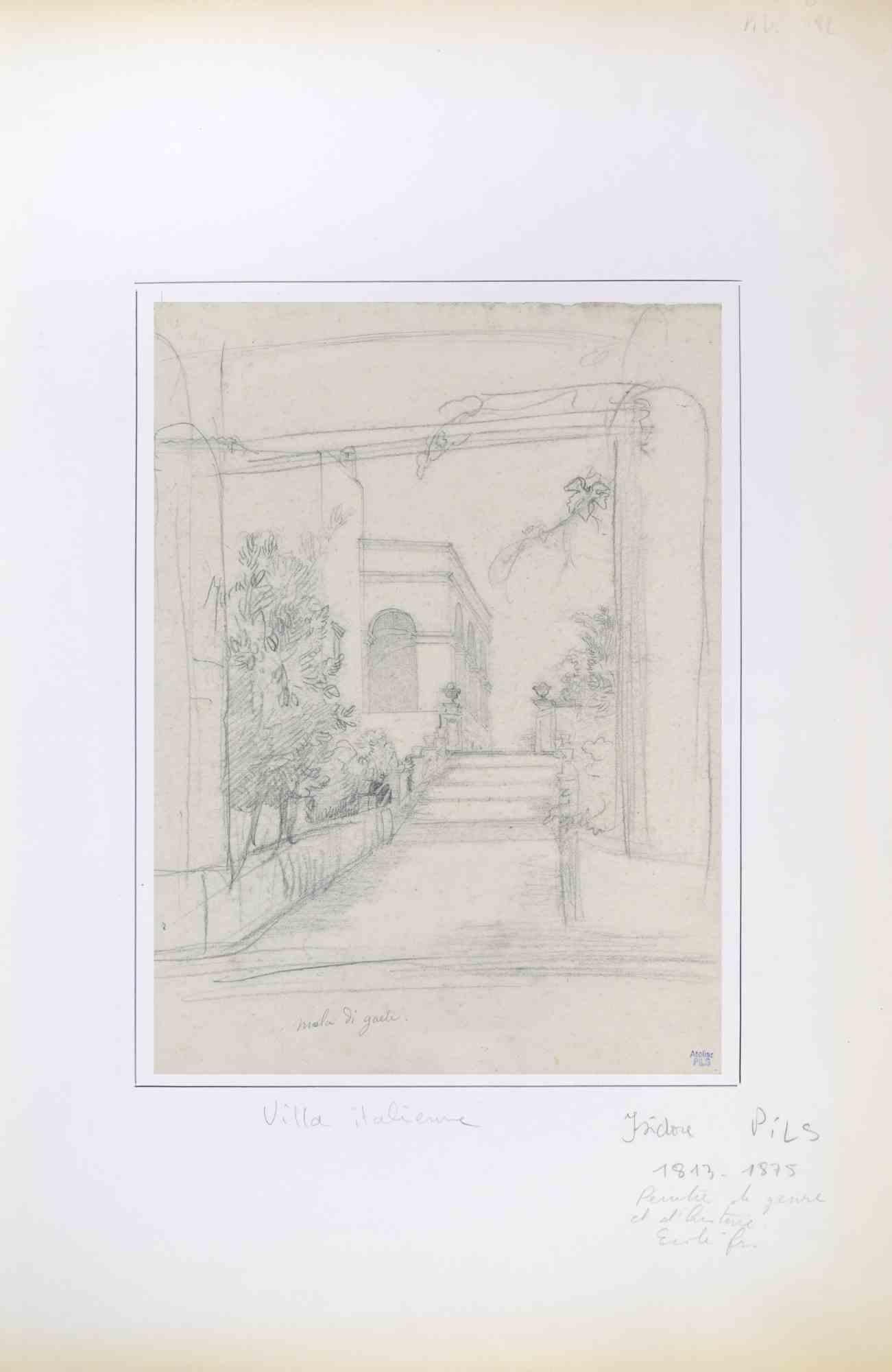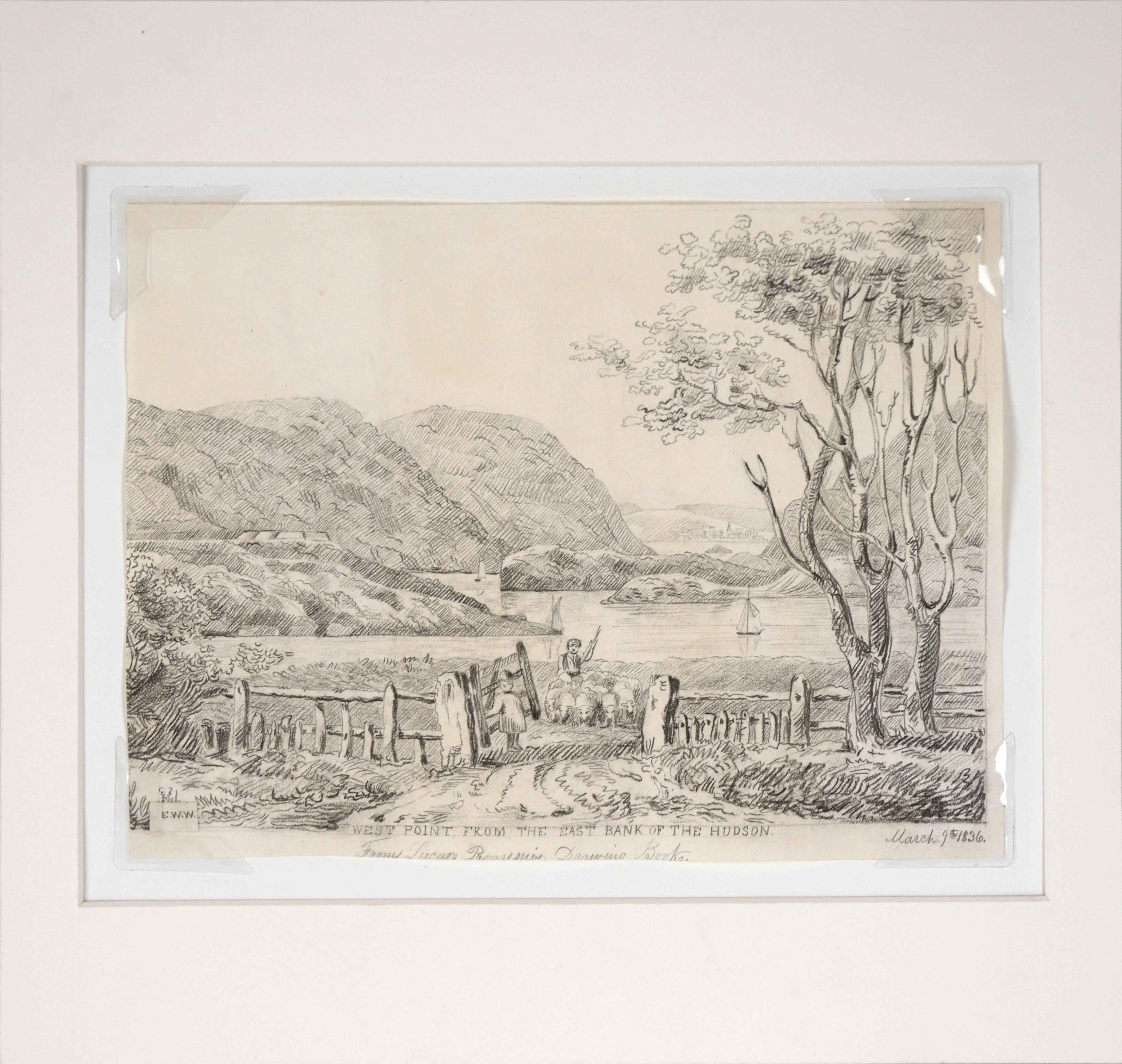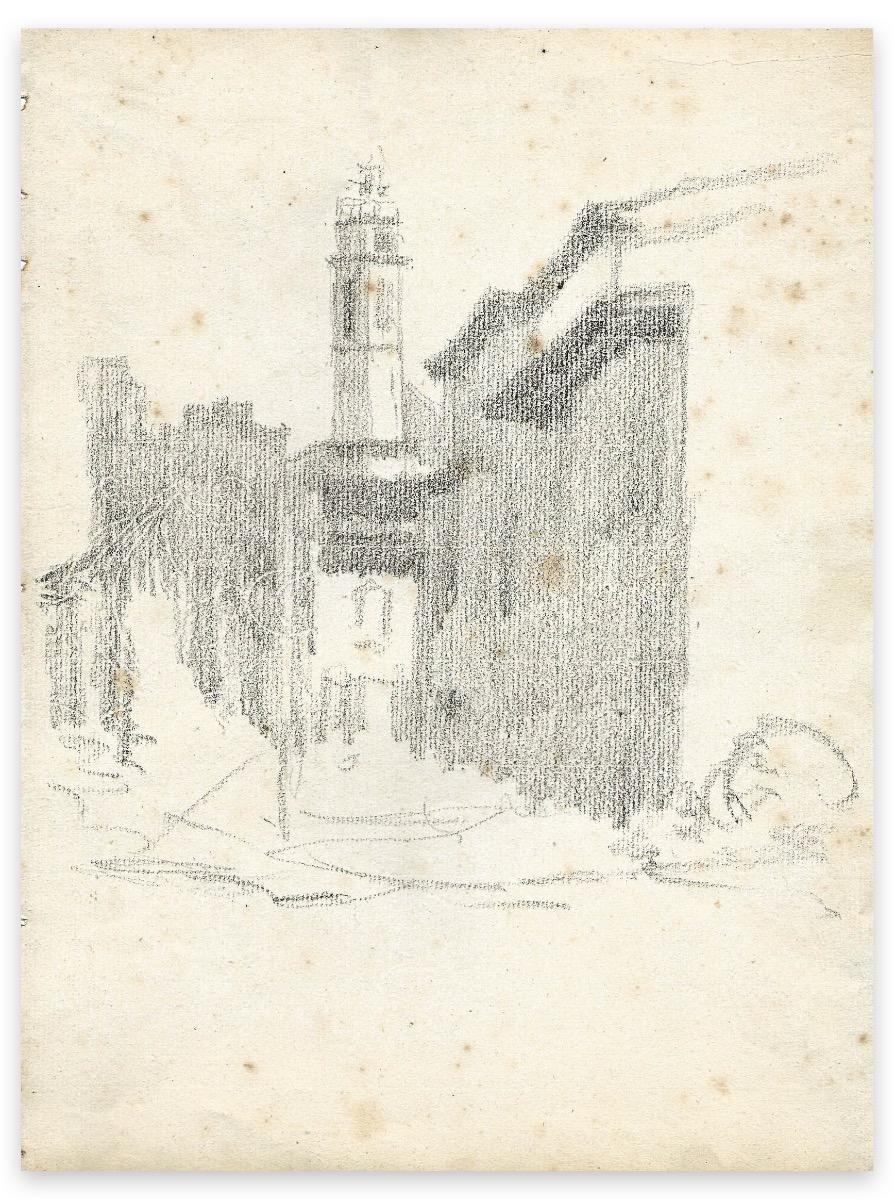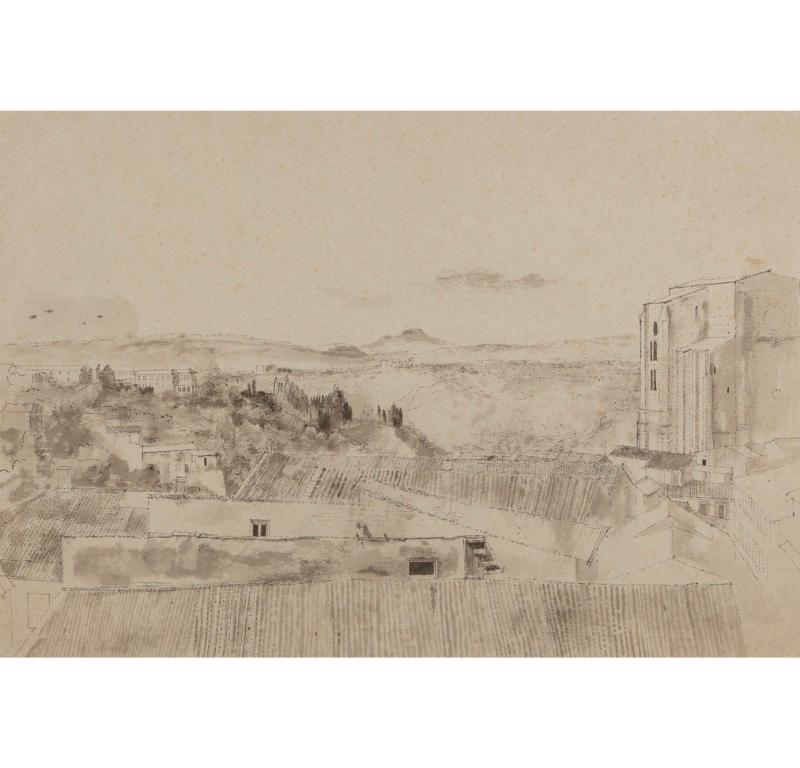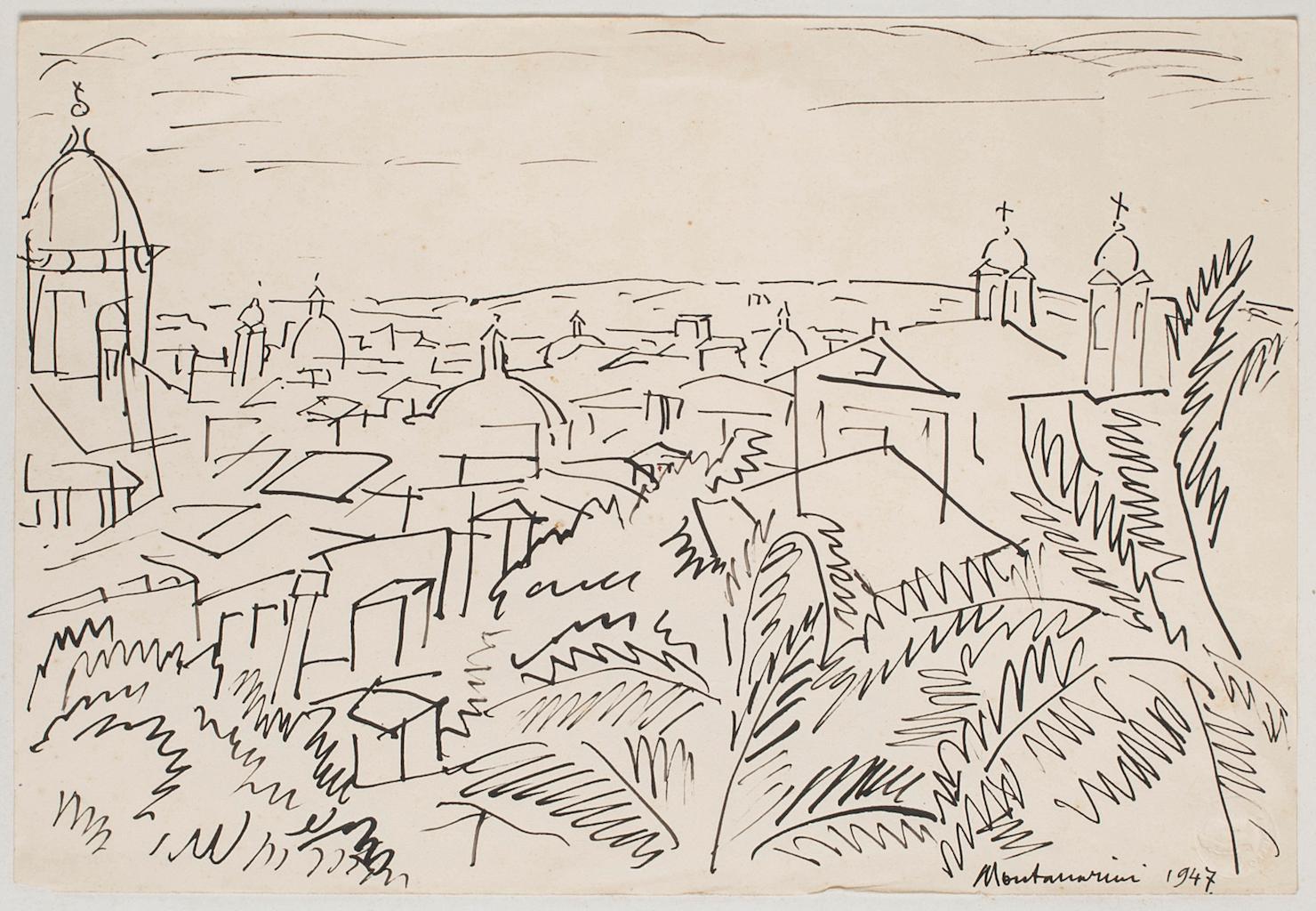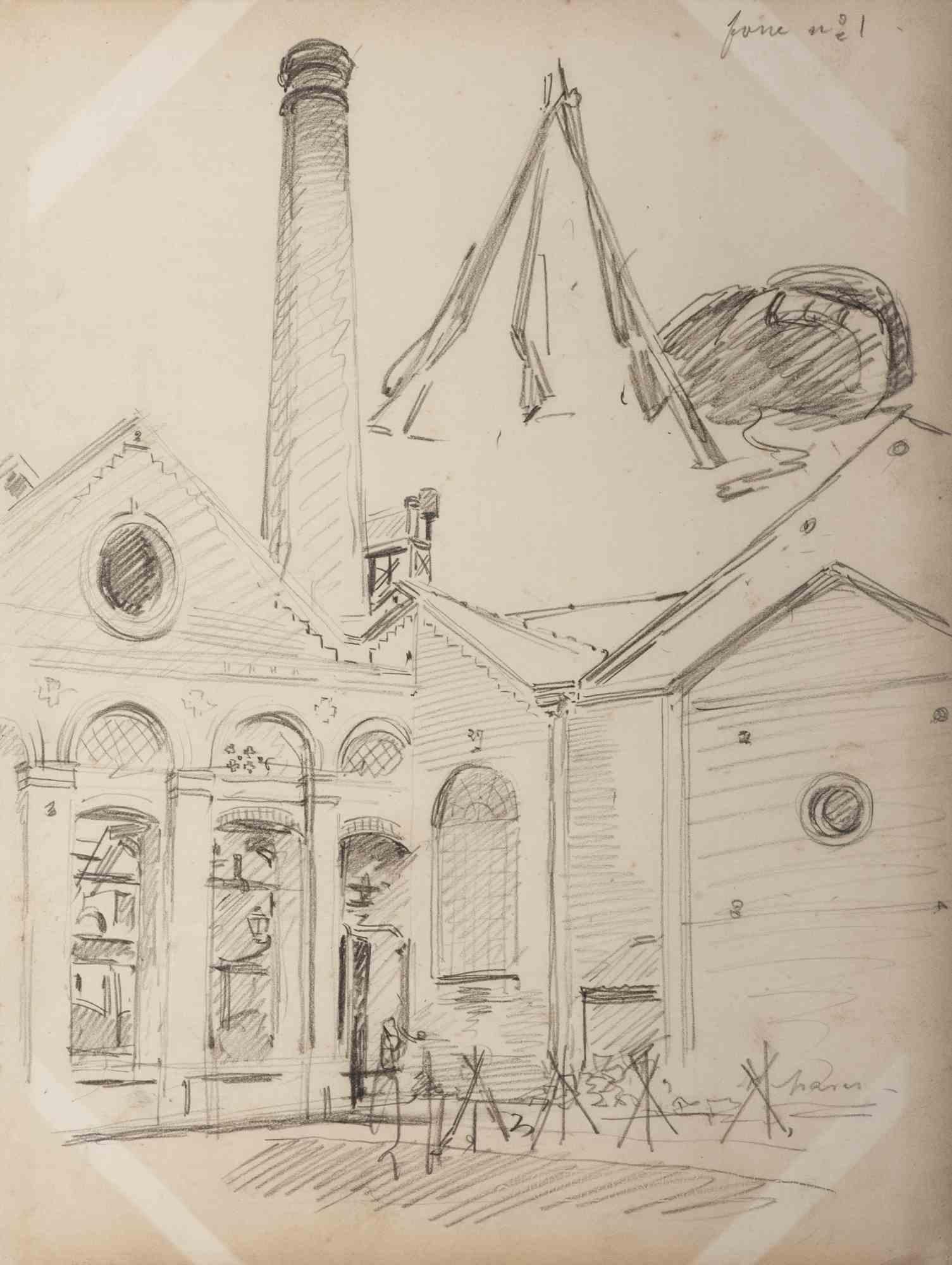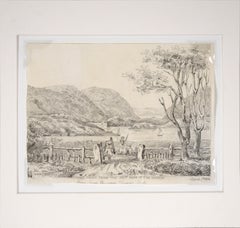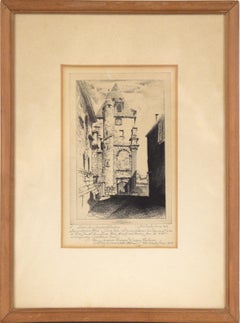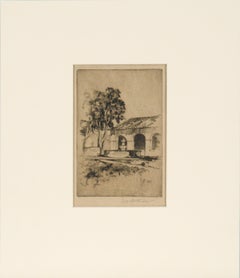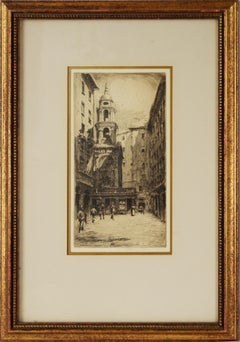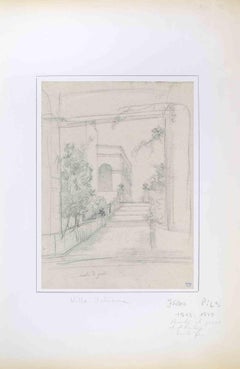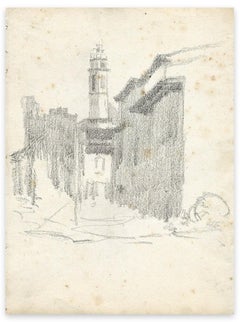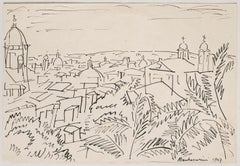Items Similar to "Funchal, Madeira Franciscans Convent" Antique Drawing on Paper Watkinson
Want more images or videos?
Request additional images or videos from the seller
1 of 11
Edward Watkinson Wells"Funchal, Madeira Franciscans Convent" Antique Drawing on Paper Watkinson1837
1837
$1,852.50
$2,85035% Off
£1,396.97
£2,149.1835% Off
€1,615.66
€2,485.6335% Off
CA$2,599.05
CA$3,998.5335% Off
A$2,889
A$4,444.6235% Off
CHF 1,514.35
CHF 2,329.7735% Off
MX$35,281.72
MX$54,279.5635% Off
NOK 18,905.83
NOK 29,085.8935% Off
SEK 17,786.86
SEK 27,364.4035% Off
DKK 12,058.83
DKK 18,552.0435% Off
About the Item
"Funchal, Madeira Franciscans Convent" Antique Drawing on Paper Watkinson
Delicate and detailed drawing of Funchal, Madeira by Hartford, Connecticut artist Edward Watkins Wells (1819-1898) "View of Funchal, Madeira from the Haywards house. The building with the Dome and the one to the right of it, was formerly a convent for Franciscans E.W. Wels 1837"
It was built on the late 15th century to house the daughters of nobility in the island. The convent was developed around a primitive church, church of Nossa Senhora da Conceição de Cima, ordered by João Gonçalves Zarco, the island's discover and first donatary captain of Funchal, to be his family tomb. The convent, dedicated to Franciscan nuns, was founded by João Gonçalves de Câmara and Donna Isabella (the convent’s first Abbess). They were the grandchildren of Zarco, who discovered the island of Madeira. Zarco is buried underneath the convent’s high alter.
Mat size: 14"H x 18"W
Paper size: 9.5"H x 13"W
Image, 7"H 12"W
Notes of interest on Edward Watkinson Wells from the Watkinson Museum at Trinity College:
Our most significant acquisition this year came from a dealer in Philadelphia. It is a 450-page diary written over 10 years (1841-1851) by Hartford artist and dilettante Edward Watkinson Wells (1819-1898), one of the many nephews of our founder, David Watkinson (1778-1857).
Edward was immersed in Hartford’s cultural life in the 1840s, exhibited his works at local fairs and gave lessons to the locals. He portrays an active involvement with with his large extended family, which often crossed and re-crossed the other prominent families of Hartford (i.e., Barnard, Channing, Dexter, Ely, Gallaudet, Gill, Goodrich, Hudson, Rockwell, Silsbee, Tappan, Terry, Tracy, Trumbull, Van Renselaer, and Wadsworth).
Edward describes dancing and costume parties, soirees, teas, dinners, and receptions in private homes and public venues. He meets Charles Dickens and his wife when they come through Hartford in 1842, and describes brushes with other luminaries, such as Col. Thomas L. McKenney (who lectures on American Indians), and the Unitarian clergyman Rev. Henry Giles, who gave a pro-Irish speech.
Other entertainments included a balloon ascension, exhibitions of mesmerism and hypnotism, parades, and performances by well-known groups. He also chronicles the progression of the construction of the Wadsworth Atheneum, and touches on his father’s far-reaching interests in the business world–canals, railroads, factories, and real estate.
The cost of this valuable document of mid-19thC Hartford was generously underwritten entirely by a member of the Watkinson Trustees.
Trinity College and the Watkinson Virtual Library has content on Edward Watkinson Wells.
Yale College also:
Edward Watkinson Wells also kept a diary, of which three volumes are preserved (folder 32). He describes a trip by steamboat to Florida, ca. 1855-1860, and the social life and customs he observed there. The other two volumes detail his daily life in Hartford during 1856-1860, and record the deaths of his father and David Watkinson in 1857.
Other items contained in the William Wells Family Papers include a large number of drawings by Edward Watkinson Wells and his mother, assorted printed matter including a sermon by William Wells (folder 63), genealogical records, memorabilia, newspaper clippings, photographs, daguerreotypes, and one tintype of family members.
Edward Watkinson Wells (American, 1819-1898) was born in Hartford, Connecticut. Wells was an artist and socialite - his diary "describes dancing and costume parties, soirees, teas, dinners, and receptions in private homes and public venues. He meets Charles Dickens and his wife when they come through Hartford in 1842, and describes brushes with other luminaries, such as Col. Thomas L. McKenney . . . and the Unitarian clergyman Rev. Henry Giles"
Reverend William Wells (1744-1827), who moved from England to Brattleboro, Vermont, in 1793, and of several families allied to his by marriage. The materials are arranged alphabetically by family member. Short biographies of William Wells, James Hancox Wells, and several others, as well as more detailed genealogical information than that provided in these partial family trees can be found in The Reverend William Wells:..., by James Hayden Wells and Anita Wells (folders 67-68). The book is based mainly on family papers preserved by James Hancox Wells and taken to California by Elisabeth Howard, although references are also made to items in Yale's William Wells Family Papers (see The Reverend William Wells, pg. 5).
- Creator:Edward Watkinson Wells (1819 - 1898, American)
- Creation Year:1837
- Dimensions:Height: 14 in (35.56 cm)Width: 18 in (45.72 cm)Depth: 0.25 in (6.35 mm)
- Medium:
- Movement & Style:
- Period:
- Condition:Excellent condition, a complete conservation was done to the drawing and the paper backing. PH balanced and acid free. By a certified paper conservator.
- Gallery Location:Soquel, CA
- Reference Number:Seller: RJA97361stDibs: LU54216402522
About the Seller
5.0
Platinum Seller
Premium sellers with a 4.7+ rating and 24-hour response times
Established in 1986
1stDibs seller since 2014
2,985 sales on 1stDibs
Typical response time: <1 hour
- ShippingRetrieving quote...Shipping from: Soquel, CA
- Return Policy
Authenticity Guarantee
In the unlikely event there’s an issue with an item’s authenticity, contact us within 1 year for a full refund. DetailsMoney-Back Guarantee
If your item is not as described, is damaged in transit, or does not arrive, contact us within 7 days for a full refund. Details24-Hour Cancellation
You have a 24-hour grace period in which to reconsider your purchase, with no questions asked.Vetted Professional Sellers
Our world-class sellers must adhere to strict standards for service and quality, maintaining the integrity of our listings.Price-Match Guarantee
If you find that a seller listed the same item for a lower price elsewhere, we’ll match it.Trusted Global Delivery
Our best-in-class carrier network provides specialized shipping options worldwide, including custom delivery.More From This Seller
View All"West Point from the East Bank of the Hudson" Antique Drawing on Paper Watkinson
Located in Soquel, CA
"West Point from the East Bank of the Hudson" Antique Drawing on Paper
Delicate and detailed drawing by Hartford, Connecticut artist Edward Watkins Wells (1819-1898) The viewer looks out past a gate at the Hudson River, with its characteristic mountain banks. A shepherd is driving a flock of sheep towards the gate and viewer. The scene appears to have been copied from a drawing book published in 1827, based on the inscription at the bottom edge.
Presented in white archival mat
Mat size: 12"H x 12"W
Paper size: 7.5"H x 9.25"W
Notes of interest on Edward Watkinson Wells
Our most significant acquisition this year came from a dealer in Philadelphia. It is a 450-page diary written over 10 years (1841-1851) by Hartford artist and dilettante Edward Watkinson Wells (1819-1898), one of the many nephews of our founder, David Watkinson (1778-1857).
Edward was immersed in Hartford’s cultural life in the 1840s, exhibited his works at local fairs and gave lessons to the locals. He portrays an active involvement with with his large extended family, which often crossed and re-crossed the other prominent families of Hartford (i.e., Barnard, Channing, Dexter, Ely, Gallaudet, Gill, Goodrich, Hudson, Rockwell, Silsbee, Tappan, Terry, Tracy, Trumbull, Van Renselaer, and Wadsworth).
Edward describes dancing and costume parties, soirees, teas, dinners, and receptions in private homes and public venues. He meets Charles Dickens and his wife when they come through Hartford in 1842, and describes brushes with other luminaries, such as Col. Thomas L. McKenney (who lectures on American Indians), and the Unitarian clergyman Rev. Henry Giles, who gave a pro-Irish speech.
Other entertainments included a balloon ascension, exhibitions of mesmerism and hypnotism, parades, and performances by well-known groups. He also chronicles the progression of the construction of the Wadsworth Atheneum, and touches on his father’s far-reaching interests in the business world–canals, railroads, factories, and real estate.
The cost of this valuable document of mid-19thC Hartford was generously underwritten entirely by a member of the Watkinson Trustees.
Trinity College and the Watkinson Virtual Library has content on Edward Watkinson Wells.
Yale College also:
Edward Watkinson Wells also kept a diary, of which three volumes are preserved (folder 32). He describes a trip by steamboat to Florida, ca. 1855-1860, and the social life and customs he observed there. The other two volumes detail his daily life in Hartford during 1856-1860, and record the deaths of his father and David Watkinson in 1857.
Other items contained in the William Wells...
Category
1830s Romantic Landscape Drawings and Watercolors
Materials
Laid Paper, Pencil
"Church of St. Aignan Chartres" Etching in Ink on Paper (Demonstration Plate)
By John Taylor Arms
Located in Soquel, CA
"Church of St. Aignan Chartres" Etching in Ink on Paper (Demonstration Plate)
Delicate and detailed drypoint etching of the Church of St. Aignan in Chartres, France by John Taylor Arms (American, 1887-1953). The viewer stands in an alley near the church, looking out of the shadows at the sunlit towers. The architectural details of the church are well-captured, including the texture of the stone walls, the roof, and ornamental detail.
Titled, signed, dated, and inscribed along the bottom edge:
Sketch, Saint Aignon, Chartres John Taylor Arms 1950
The inscription includes details about production, as well as a dedication "To my friends Georgia and Jasper Mathews, with my sincerest good wishes"
Presented in a wood frame with an off-white mat.
Frame size: 12.5"H x 9.25"W
Image size: 7"H x 4.5"W
John Taylor Arms was born in Washington, DC in 1887. He studied law at Princeton University, transferring to the Massachusetts Institute of Technology, Boston, to study architecture, graduating in 1912. After serving as an officer in the United States Navy during World War I, he devoted himself full-time to etching. He published his first original etchings in 1919.
His initial subject was the Brooklyn Bridge in New York City near which he worked. Arms developed a successful career as a graphic artist in the 1920s and 1930s, specializing in series of etchings of Gothic churches and cathedrals in France and Italy. In addition to medieval subjects, Arms made a series of prints of American cities.
He used sewing needles and magnifying glasses to get a fine level of detail. A member of many printmaking societies, Arms served as president of the Society of American Graphic Artists. An educator, Arms wrote the Handbook of Print Making and Print Makers (1934) and did numerous demonstrations and lectures. Arms was elected into the National Academy of Design as an Associate member in 1930, and became a full member in 1933. His work was also part of the painting event in the art competition at the 1932 Summer Olympics...
Category
1940s Victorian Still-life Prints
Materials
Paper, Ink, Drypoint, Etching
Palm Springs Courtyard with Fountain - Drypoint Etching on Paper
Located in Soquel, CA
Palm Springs Courtyard with Fountain - Drypoint Etching on Paper
Stately drypoint etching of the courtyard of a Palm Springs house by Leland "Lee" Fuller (American, 1899-1962). The focus of this piece is the courtyard of a house with a fountain. Behind the garden and fountain, there is a section of the house with an arched doorway and tile roof. This was likely a house that Fuller designed. From the Robert Azensky Fine Art Mary Pickford...
Category
1920s American Impressionist Landscape Prints
Materials
Paper, Ink, Drypoint
Church of San Pietro In Banchi, Italy - 1908 Original Etching
Located in Soquel, CA
Church of San Pietro In Banchi, Italy - 1908 Original Etching
Original 1908 etching of the church of San Pietro Banchi in Genoa, Italy by George Walter Chandler (American, 1866-1928...
Category
Early 1900s Post-Impressionist Landscape Prints
Materials
Laid Paper, Etching
Late 19th Century Normandy French Market Engraving
By Charles John Watson
Located in Soquel, CA
Charming engraving of the market in Aumale, France in Normandy by Charles John Watson (British, 1846-1927), circa 1880. Signed within engraving and below by artist. Presented under g...
Category
1880s Impressionist Landscape Prints
Materials
Paper, India Ink
Street in Alfama Neighborhood Lisbon Portugal in Watercolor on Paper by Quignard
Located in Soquel, CA
Street in Alfama Neighborhood, Lisbon, Portugal in Watercolor on Paper
Detailed watercolor by unknown artist "Quignard" (French, 20th C...
Category
Late 20th Century Impressionist Figurative Drawings and Watercolors
Materials
Paper, Watercolor
You May Also Like
Italian Villa - Drawing By Isidore Pils - Mid-20th Century
Located in Roma, IT
Italian Villa is an artwork realized by Isidore Pils in the Mid 20th Century.
Pencil drawing.
In good conditions.
Hand-Signed.
Category
Mid-20th Century Modern Figurative Drawings and Watercolors
Materials
Paper, Ink
Street and Church - Original Drawing by George-Henri Tribout -Early 20th Century
By Georges-Henri Tribout
Located in Roma, IT
Street and Church is an original artwork realized by George Henri Tribout.
Original pencil drawing signed on the back of sheet G.T.
This interesting drawing shows a beautiful stree...
Category
Early 20th Century Modern Figurative Drawings and Watercolors
Materials
Paper, Pencil
Italian Scene, Pen and Ink with Wash Painting by Reginald Brill, 1950s circa
By Reginald Brill
Located in Kingsclere, GB
Italian Scene, Pen and Ink with Wash Painting by Reginald Brill, 1950s circa
Additional information:
Medium: Pen and ink with wash
33 x 48.3 cm
13 x 19 in
Reginald " Reggie" Brill was a versastile 20th century artist and teacher.
Brill was born in London in 1902 and spent his early childhood there and in Yorkshire. By the time of the First World War, at the age of 13, he was living in lodgings in London, working in a City office and attending St Martins School of Art in the evenings. Considering his lack of education, winning a scholarship to The Slade (now part of University College London) in 1921 where he studied under Henry Tonks for three years, was a huge achievement.
On leaving The Slade he found patronage in Lincolnshire, but by the time of the General Strike (1926) he had returned to London and was working on Lansbury's Labour Weekly. He married Rosalie, also an artist, and in 1927 won the Prix de Rome in Decorative Painting. Following two years at The British School in Rome, Brill went to teach at Blackheath School of Art. During 1930 he spent three months painting in Egypt and it was there that he met Col. T G Gayer-Anderson, one of the twin brothers who were to bequeath The Little Hall in Lavenham as a hostel for art students. It was there that Brill retired to act as warden, thus continuing his nurturing of art students until his death in 1972.
Brill took up his appointment at The School of Art, Kingston upon Thames in January 1934. It was situated in the Technical Institute (Kingston Hall Road) and Brill found it bohemian and disorganised. He proceeded to inject enthusiasm, order and discipline. Within 5 years of his appointment a purpose-built School of Art was opened in Knights Park. It remained open throughout the war and by 1945 there was a waiting list for places. Under the skilled and totally dedicated direction of Brill, Kingston School of Art became established with national reputation for excellence. In 1961 Sir Charles Wheeler opened the new building at Knights Park. Costing £100,000, this more than doubled the size of the Art School.
Brill, was a well-known figure in Kingston. His eloquence made him popular as a guest speaker and his promotion of Art and Design stretched well beyond the doors of Knights Park. Apart from establishing two of the main buildings which makeup what is now known as the Faculty of Design, one of the most visible local contributions he made was the setting up of a topographical collection of paintings depicting Kingston, which has since become known as The Brill Collection at Kingston Museum. Brill gained huge respect and admiration from the hundreds of pupils who studied at Kingston during his 30-year leadership.
He published two books, Modern Painting 1946 and Art as a Career 1962, both bearing a strong educational angle. He regularly exhibited along with leading artists of his era at The Royal Academy, both his paintings and his acutely observed drawings. All the while he was a prolific artist, although reading his diaries, intensely self-critical. His perfectionism, acute powers of observation and relentless research can be seen in his drawings, which via the media and methods he explored throughout his life reflect mid 20th century British Art at its most typical. His major series of work, known as 'The Martyrdom of Man', was carried on in parallel to his career as a teacher. These paintings reflect his care for fellow man and depict people at work, e.g., The Operation, The Jury, Linemen, Waiting Room and Rest, which recently sold at Sotheby’s and was specially restored for The Brill Retrospective. His smaller works also play with the theme of everyday events and communication amongst people, such as The Bull Ring and Market Place paintings.
Brill's name is associated particularly with human figure compositions, but he also worked on landscapes, portraits and details of plants, animals, interiors etc. As one would expect he moved from one media to another, and his unusual hand painted and cut paper mosaics...
Category
20th Century Landscape Paintings
Materials
Pen
View of Rome - Original Pen Drawing on Paper by Luigi Montanarini - 1947
By Luigi Montanarini
Located in Roma, IT
View of Rome is an original drawing in pen realized by Luigi Montanarini in 1947.
Hand-signed by the artist on the lower right margin.
Passepartout: 48.5 x 65
Good condition excep...
Category
1940s Figurative Drawings and Watercolors
Materials
Pen
The Cathedral - Drawing in pencil on paper by Paul Renouard - Early 20th Century
By Charles Paul Renouard
Located in Roma, IT
The Cathedral is a drawing in pencil on paper realized Early 20th Century by Paul Renouard (1845-1924).
Good condition with slight foxing and a small missing piece on the lower righ...
Category
Early 20th Century Modern Figurative Drawings and Watercolors
Materials
Pencil
Parisian Houses - Original Etching by Jaques Berger - Mid-20th Century
Located in Roma, IT
Parisian Houses is an original etching print on paper realized by Jaques Berger(1912-1978) artist of the mid-20th Century.
Hand-signed and numbered, from a rare edition of 4 prints...
Category
Mid-20th Century Modern Landscape Prints
Materials
Etching
More Ways To Browse
Weller Antique
Antique Well
Large Landscape Drawing
Antique Drawing Book
Antique Paper Documents
Antique Alter
Charles H Wells
Trinity College
Indian Pencil
Watercolor Prints Trees
Antique Railroad
Henry Church
Pencil Drawing Church
Charles Church
Antique Church Cross
Socialite Painting
Artist Gill
Indian Antique House
